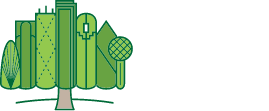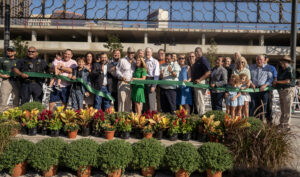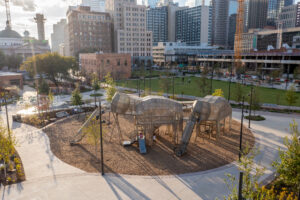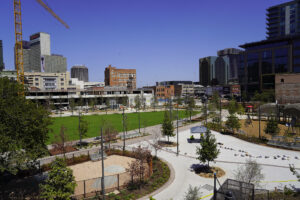Crafting a vision for Dallas’ downtown parks requires collaboration. The region’s elected officials, city staff, business owners and experts from a variety of disciplines must work together to create green spaces that, in addition to being beautiful, will remain functional for decades to come.
Dallas is fortunate to have Christine Ten Eyck, president of and chief landscape architect for Austin’s Ten Eyck Landscape Architects (TELA), leading the design efforts for Harwood Park. Christine has deep Dallas roots and for the past 20 years has been working at the forefront of her profession. Her landscape designs are widely celebrated for their emphasis on environmental sustainability, their incorporation of native plants and locally sourced materials and their distinctive elegance. Christine has received the United States Senate Congressional Commendation for Historic Preservation, the National Trust for Historic Preservation Landscape Architecture Award and the U.S. Army Corps of Engineers Chief of Engineers Award of Excellence, among other honors.
Downtown Dallas Parks Conservancy recently sat down with Christine to learn more about how she sees Harwood Park enriching the lives of Dallas residents now and into the future.
What makes the Harwood Park project unique?
It’s unique for a public open space to incorporate historic structures at its perimeter to augment both active and passive recreational opportunities. Its location provides extraordinary views of the Dallas skyline and much-needed green space for the neighborhoods being built in the farmers market area. It also offers relief to the nearby, heavily used Main Street Garden.
What are your thoughts on incorporating more quality green spaces into downtown Dallas?
The physical and mental health benefits of green, open spaces for urban dwellers and visitors are well documented. But often overlooked are the benefits to the urban environment, including water quality improvements, rainfall retention, reduced heat buildup and improved air quality. As the downtown residential population increases, the percentage of retained open space developed for parks is essential to the health of the growing population and environment. Dallas has a comparatively small amount of downtown green space compared to other major cities.
What are some of the other projects you’ve worked on in Dallas and across the state?
I was born in Dallas and my grandfather was an architect in Dallas his entire life. I started my career in Dallas with James Lambert and Associates and then Naud Burnett and Partners. I worked on many Highland Park residences, as well as the Dallas Garden Center master plan. Recent projects in the Dallas area include the new Parkland Hospital, a large campus in Las Colinas and the Salt Lick Grapevine. In San Antonio, we’re working on a new visitor entry and Family Adventure Garden for the San Antonio Botanical Garden, as well as the Pearl Brewery plaza marketplace and The Cellars. In Houston, we’re working on the new Rice Performing Arts Center and the new Moody Green. We have just completed a $22 million campus transformation project for the University of Texas at El Paso, which is the first Sustainable SITES-certified project in the world.
How do you see Harwood Park changing the way people experience downtown Dallas?
The growth of urban dwellers in and around the Farmers Market District of downtown Dallas requires additional open space as a relief from the density of humans and buildings. Harwood Park will provide an outlet for local residents and visitors alike to access green space, exercise, dine, relax, hang out with friends, see a movie, attend a concert or just enjoy time with family. With access from nearby DART lines, the park also provides an attraction for visitors to experience downtown Dallas while immersed in the Dallas skyline.
How do you see all four of PfDD’s projects affecting downtown Dallas in the next five years? The next 10 years?
Urban parks historically evolve as the needs of visitors and nearby residents change through time. The DDPC projects provide a diversity of activities and experiences that, when viewed as a whole, will be attractive to a diverse populace of downtown residents and visitors alike. As the requirements of park users evolve, programmatic adjustments can be made during the next decade. The unique aspect of these four parks is that they will have their own identity and programmatic basis but, due to the relatively close proximity of the parks, will function as a system to allow users to move relatively easily from one park to another for access to a diversity of activities.
There’s research that says a connection with nature makes people and cities healthier. This would be my hope for downtown Dallas — that these parks sustain and improve the lives of urban dwellers in the years to come and be an impetus for further development of new parks and pedestrian-oriented streetscapes in downtown that connect with each other.
What’s your favorite amenity or design feature you’ll be implementing in the park?
My favorite design feature that will make this park unique from others is the interplay of the historic buildings with the landscape and courtyards. Protected microclimates in the courtyard spaces between the buildings will shield park users from the harsh sun. Our team is working on ways to open the existing buildings up to the park that blur the lines between landscape and architecture by creating interesting people spaces between, in and around these historic structures.
Are there any fun facts or things the general public may not already know about the park or location that you’d like to share with us?
The Harwood history and former uses of the site are very interesting. The site started out as a residential neighborhood and then grew more commercial, eventually becoming the film district of Dallas. People would come from small towns all over Texas to check out films and buy supplies such as popcorn for their drive-in theaters. Also, there was a tributary creek that used to flow through the site and we’re marking its approximate path through the park with a rainwater harvesting garden.
What are your favorite parks that you’ve visited in the U.S. and around the world?
Central Park, Bryant Park and High Line in New York City; Millennium Park, Chicago; and in Europe: Park Guell in Barcelona and Luxembourg Gardens in Paris.
What’s one city you think is “doing it right” in terms of urbanization in its downtown area? How do you think Dallas will compare once the four parks are built?
In the States, I would vote for New York because of its dedication to its existing parks and to new open space. Parks such as Central, Bryant and Madison Square parks — combined with its new parks — are starting to create a real green network in the city. With High Line, developers took a historic rail line and turned it into one of the most visited parks, which also serves as a connector, gathering place and viewpoint to other green and downtown spaces in the city. Downtown Dallas will benefit from having more green connections and spaces to create a network of pedestrian-friendly outdoor environments that link different districts of downtown, as demonstrated with Klyde Warren Park, joining Uptown residential to the north to the Arts District. Dallas is a wonderful city and needs to be able to compete with other major cities in its quality of life for office workers, residents and downtown visitors. The 2016 Park Score, conducted by the Project for Public Spaces, ranks Dallas at No. 54 in the nation behind U.S. cities such as Pittsburgh, Las Vegas, Portland, New York, Chicago, Seattle, San Francisco and Philadelphia. The addition of the four new DDPC parks in downtown Dallas will do much toward closing the gap of usable open park space with other U.S. cities.
You can get a sneak peek of Christine’s designs for Harwood Park on the Downtown Dallas Parks Conservancy blog. And remember, these plans are just that. Dallas citizens have multiple opportunities to participate in making Harwood Park the best possible park for the neighborhoods it will serve. To make your voice heard in the conversations to come, stay up to date on the latest park planning developments by connecting with us on Facebook and Twitter and signing up for our newsletter.





